Critical Review of Literature: Performance Management in Organizations
VerifiedAdded on 2022/12/18
|6
|1135
|47
Essay
AI Summary
This essay presents a critical review of two scholarly articles concerning performance management. The first article, "Performance management effectiveness: lessons from world-leading firms," examines the effectiveness of performance management through case studies of leading global organizations, utilizing signaling theory to analyze internal communication strategies and their impact on employee perception and alignment with company objectives. The second article, "Performance management effectiveness: practices or context?" explores the relationship between organizational practices and contextual factors in achieving effective performance management, studying a large sample of organizations to determine the influence of these factors on overall performance. The essay identifies the points of agreement and disagreement between the two articles, highlighting their differing focuses and approaches to understanding and improving performance management systems.
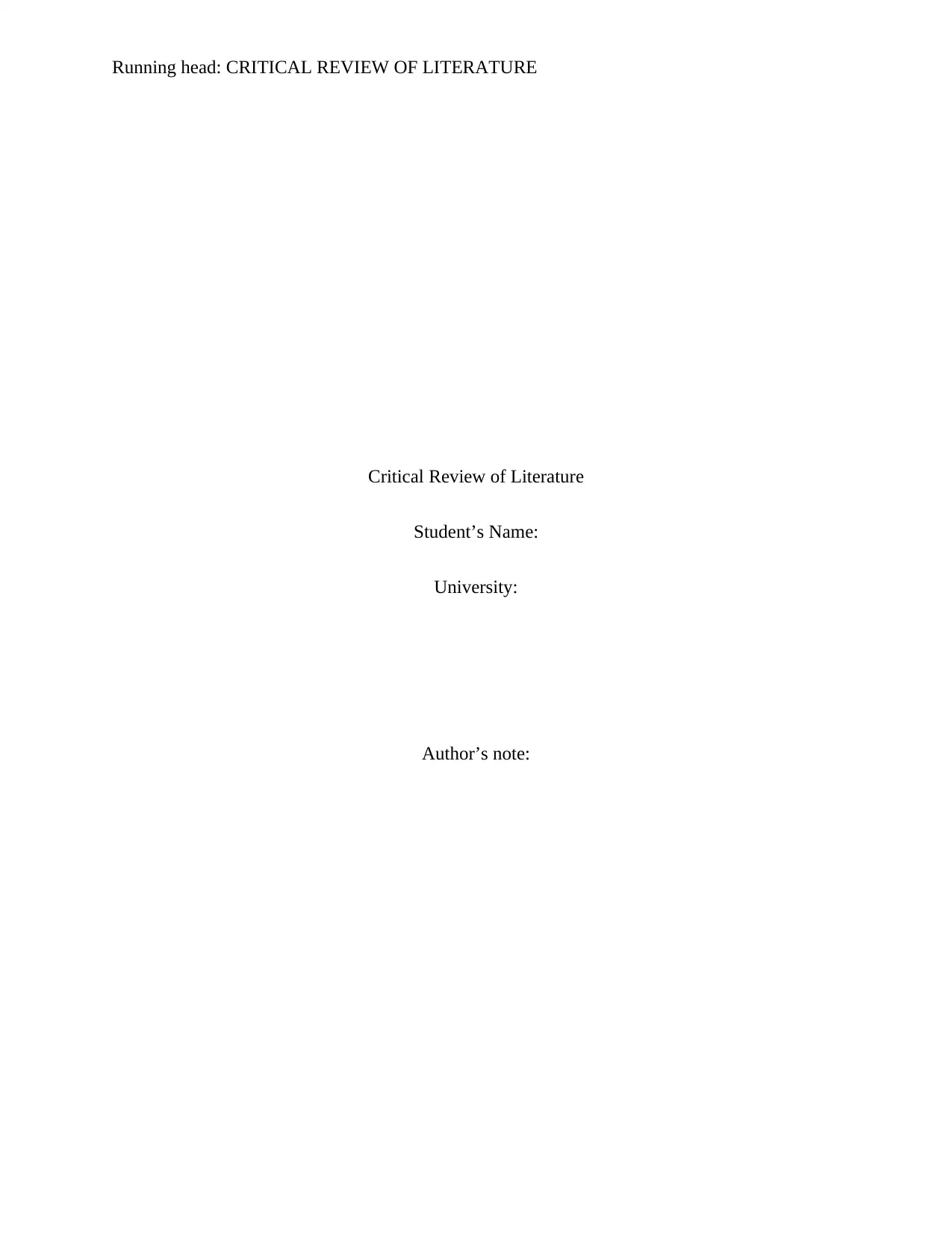
Running head: CRITICAL REVIEW OF LITERATURE
Critical Review of Literature
Student’s Name:
University:
Author’s note:
Critical Review of Literature
Student’s Name:
University:
Author’s note:
Paraphrase This Document
Need a fresh take? Get an instant paraphrase of this document with our AI Paraphraser
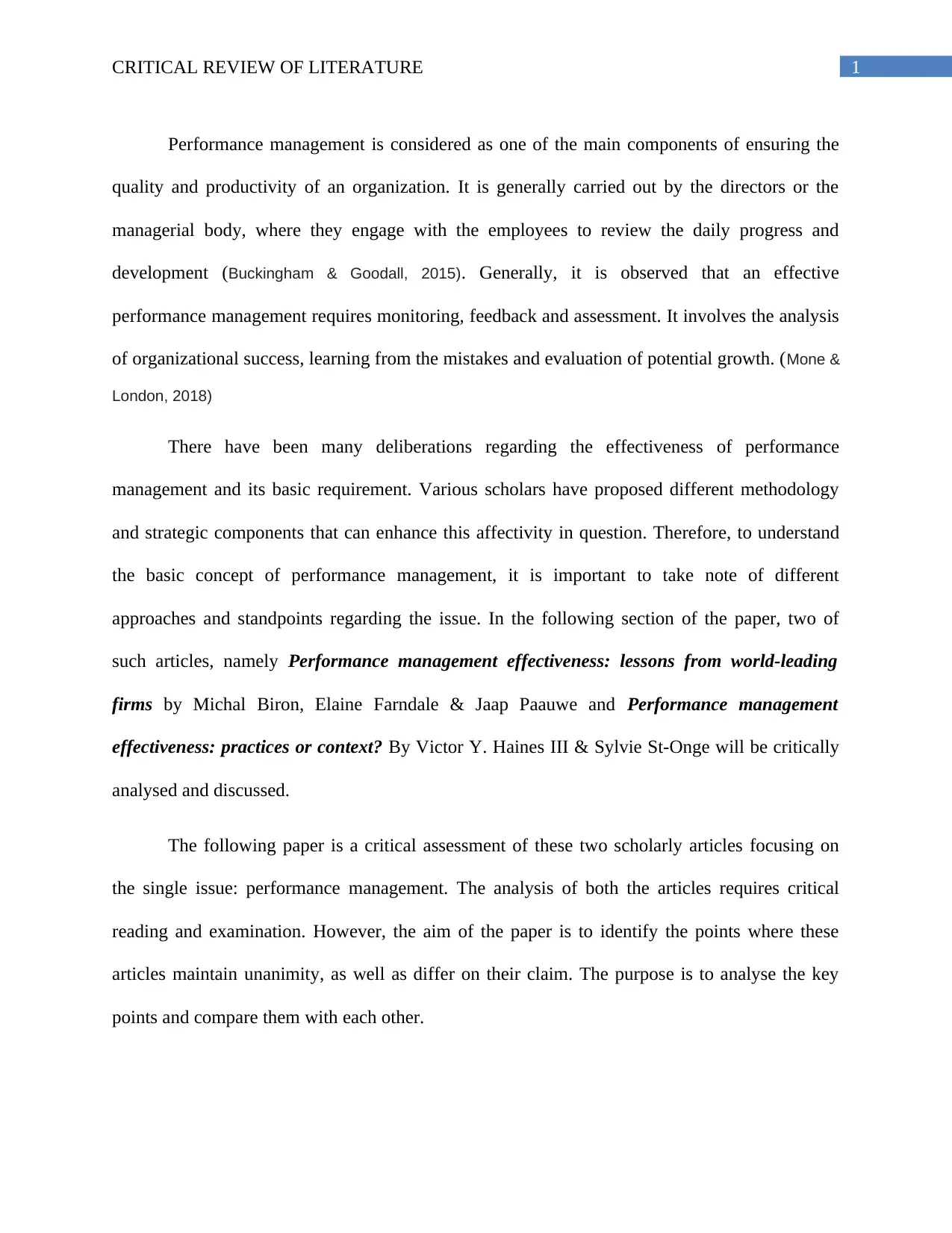
1CRITICAL REVIEW OF LITERATURE
Performance management is considered as one of the main components of ensuring the
quality and productivity of an organization. It is generally carried out by the directors or the
managerial body, where they engage with the employees to review the daily progress and
development (Buckingham & Goodall, 2015). Generally, it is observed that an effective
performance management requires monitoring, feedback and assessment. It involves the analysis
of organizational success, learning from the mistakes and evaluation of potential growth. (Mone &
London, 2018)
There have been many deliberations regarding the effectiveness of performance
management and its basic requirement. Various scholars have proposed different methodology
and strategic components that can enhance this affectivity in question. Therefore, to understand
the basic concept of performance management, it is important to take note of different
approaches and standpoints regarding the issue. In the following section of the paper, two of
such articles, namely Performance management effectiveness: lessons from world-leading
firms by Michal Biron, Elaine Farndale & Jaap Paauwe and Performance management
effectiveness: practices or context? By Victor Y. Haines III & Sylvie St-Onge will be critically
analysed and discussed.
The following paper is a critical assessment of these two scholarly articles focusing on
the single issue: performance management. The analysis of both the articles requires critical
reading and examination. However, the aim of the paper is to identify the points where these
articles maintain unanimity, as well as differ on their claim. The purpose is to analyse the key
points and compare them with each other.
Performance management is considered as one of the main components of ensuring the
quality and productivity of an organization. It is generally carried out by the directors or the
managerial body, where they engage with the employees to review the daily progress and
development (Buckingham & Goodall, 2015). Generally, it is observed that an effective
performance management requires monitoring, feedback and assessment. It involves the analysis
of organizational success, learning from the mistakes and evaluation of potential growth. (Mone &
London, 2018)
There have been many deliberations regarding the effectiveness of performance
management and its basic requirement. Various scholars have proposed different methodology
and strategic components that can enhance this affectivity in question. Therefore, to understand
the basic concept of performance management, it is important to take note of different
approaches and standpoints regarding the issue. In the following section of the paper, two of
such articles, namely Performance management effectiveness: lessons from world-leading
firms by Michal Biron, Elaine Farndale & Jaap Paauwe and Performance management
effectiveness: practices or context? By Victor Y. Haines III & Sylvie St-Onge will be critically
analysed and discussed.
The following paper is a critical assessment of these two scholarly articles focusing on
the single issue: performance management. The analysis of both the articles requires critical
reading and examination. However, the aim of the paper is to identify the points where these
articles maintain unanimity, as well as differ on their claim. The purpose is to analyse the key
points and compare them with each other.
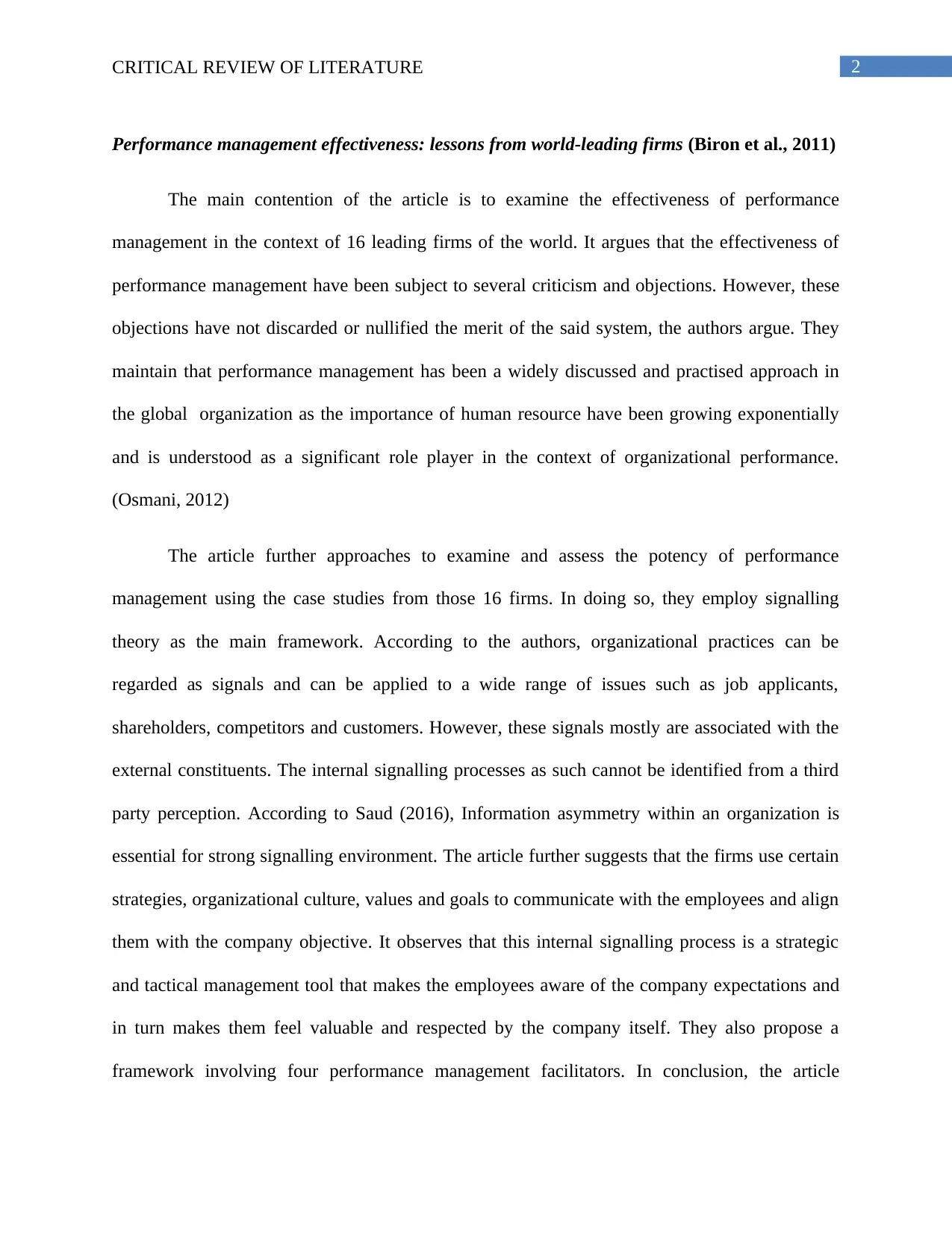
2CRITICAL REVIEW OF LITERATURE
Performance management effectiveness: lessons from world-leading firms (Biron et al., 2011)
The main contention of the article is to examine the effectiveness of performance
management in the context of 16 leading firms of the world. It argues that the effectiveness of
performance management have been subject to several criticism and objections. However, these
objections have not discarded or nullified the merit of the said system, the authors argue. They
maintain that performance management has been a widely discussed and practised approach in
the global organization as the importance of human resource have been growing exponentially
and is understood as a significant role player in the context of organizational performance.
(Osmani, 2012)
The article further approaches to examine and assess the potency of performance
management using the case studies from those 16 firms. In doing so, they employ signalling
theory as the main framework. According to the authors, organizational practices can be
regarded as signals and can be applied to a wide range of issues such as job applicants,
shareholders, competitors and customers. However, these signals mostly are associated with the
external constituents. The internal signalling processes as such cannot be identified from a third
party perception. According to Saud (2016), Information asymmetry within an organization is
essential for strong signalling environment. The article further suggests that the firms use certain
strategies, organizational culture, values and goals to communicate with the employees and align
them with the company objective. It observes that this internal signalling process is a strategic
and tactical management tool that makes the employees aware of the company expectations and
in turn makes them feel valuable and respected by the company itself. They also propose a
framework involving four performance management facilitators. In conclusion, the article
Performance management effectiveness: lessons from world-leading firms (Biron et al., 2011)
The main contention of the article is to examine the effectiveness of performance
management in the context of 16 leading firms of the world. It argues that the effectiveness of
performance management have been subject to several criticism and objections. However, these
objections have not discarded or nullified the merit of the said system, the authors argue. They
maintain that performance management has been a widely discussed and practised approach in
the global organization as the importance of human resource have been growing exponentially
and is understood as a significant role player in the context of organizational performance.
(Osmani, 2012)
The article further approaches to examine and assess the potency of performance
management using the case studies from those 16 firms. In doing so, they employ signalling
theory as the main framework. According to the authors, organizational practices can be
regarded as signals and can be applied to a wide range of issues such as job applicants,
shareholders, competitors and customers. However, these signals mostly are associated with the
external constituents. The internal signalling processes as such cannot be identified from a third
party perception. According to Saud (2016), Information asymmetry within an organization is
essential for strong signalling environment. The article further suggests that the firms use certain
strategies, organizational culture, values and goals to communicate with the employees and align
them with the company objective. It observes that this internal signalling process is a strategic
and tactical management tool that makes the employees aware of the company expectations and
in turn makes them feel valuable and respected by the company itself. They also propose a
framework involving four performance management facilitators. In conclusion, the article
⊘ This is a preview!⊘
Do you want full access?
Subscribe today to unlock all pages.

Trusted by 1+ million students worldwide
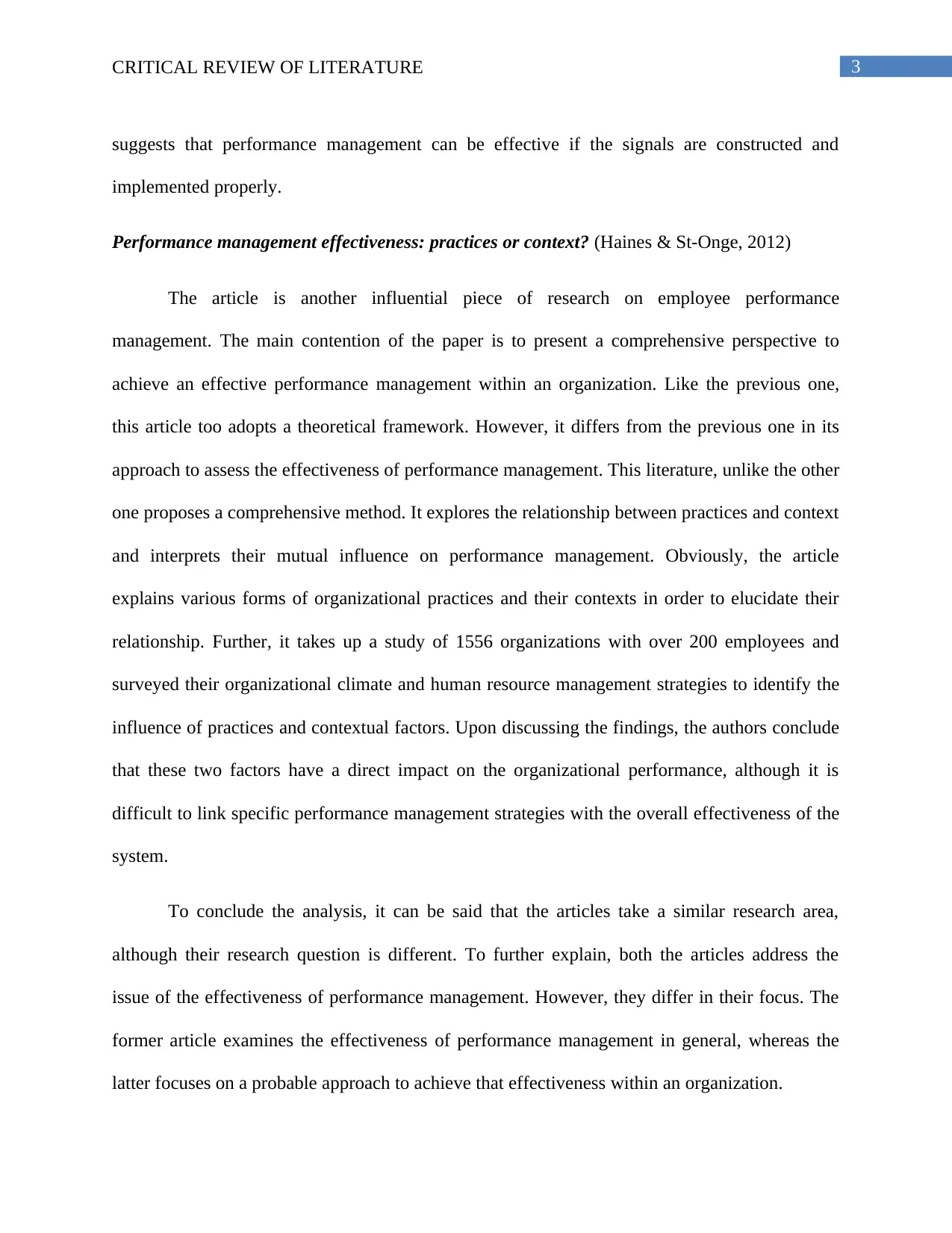
3CRITICAL REVIEW OF LITERATURE
suggests that performance management can be effective if the signals are constructed and
implemented properly.
Performance management effectiveness: practices or context? (Haines & St-Onge, 2012)
The article is another influential piece of research on employee performance
management. The main contention of the paper is to present a comprehensive perspective to
achieve an effective performance management within an organization. Like the previous one,
this article too adopts a theoretical framework. However, it differs from the previous one in its
approach to assess the effectiveness of performance management. This literature, unlike the other
one proposes a comprehensive method. It explores the relationship between practices and context
and interprets their mutual influence on performance management. Obviously, the article
explains various forms of organizational practices and their contexts in order to elucidate their
relationship. Further, it takes up a study of 1556 organizations with over 200 employees and
surveyed their organizational climate and human resource management strategies to identify the
influence of practices and contextual factors. Upon discussing the findings, the authors conclude
that these two factors have a direct impact on the organizational performance, although it is
difficult to link specific performance management strategies with the overall effectiveness of the
system.
To conclude the analysis, it can be said that the articles take a similar research area,
although their research question is different. To further explain, both the articles address the
issue of the effectiveness of performance management. However, they differ in their focus. The
former article examines the effectiveness of performance management in general, whereas the
latter focuses on a probable approach to achieve that effectiveness within an organization.
suggests that performance management can be effective if the signals are constructed and
implemented properly.
Performance management effectiveness: practices or context? (Haines & St-Onge, 2012)
The article is another influential piece of research on employee performance
management. The main contention of the paper is to present a comprehensive perspective to
achieve an effective performance management within an organization. Like the previous one,
this article too adopts a theoretical framework. However, it differs from the previous one in its
approach to assess the effectiveness of performance management. This literature, unlike the other
one proposes a comprehensive method. It explores the relationship between practices and context
and interprets their mutual influence on performance management. Obviously, the article
explains various forms of organizational practices and their contexts in order to elucidate their
relationship. Further, it takes up a study of 1556 organizations with over 200 employees and
surveyed their organizational climate and human resource management strategies to identify the
influence of practices and contextual factors. Upon discussing the findings, the authors conclude
that these two factors have a direct impact on the organizational performance, although it is
difficult to link specific performance management strategies with the overall effectiveness of the
system.
To conclude the analysis, it can be said that the articles take a similar research area,
although their research question is different. To further explain, both the articles address the
issue of the effectiveness of performance management. However, they differ in their focus. The
former article examines the effectiveness of performance management in general, whereas the
latter focuses on a probable approach to achieve that effectiveness within an organization.
Paraphrase This Document
Need a fresh take? Get an instant paraphrase of this document with our AI Paraphraser

4CRITICAL REVIEW OF LITERATURE
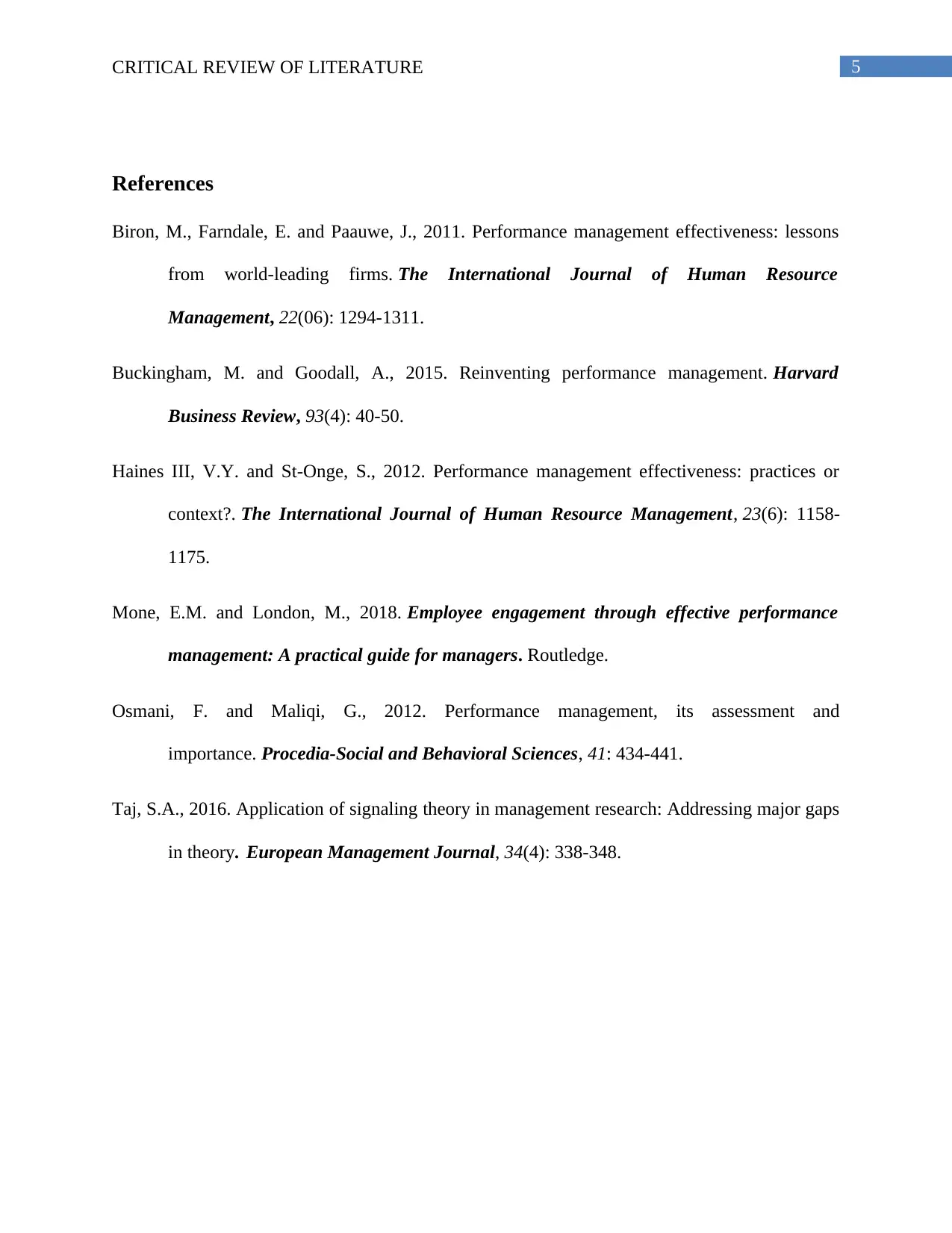
5CRITICAL REVIEW OF LITERATURE
References
Biron, M., Farndale, E. and Paauwe, J., 2011. Performance management effectiveness: lessons
from world-leading firms. The International Journal of Human Resource
Management, 22(06): 1294-1311.
Buckingham, M. and Goodall, A., 2015. Reinventing performance management. Harvard
Business Review, 93(4): 40-50.
Haines III, V.Y. and St-Onge, S., 2012. Performance management effectiveness: practices or
context?. The International Journal of Human Resource Management, 23(6): 1158-
1175.
Mone, E.M. and London, M., 2018. Employee engagement through effective performance
management: A practical guide for managers. Routledge.
Osmani, F. and Maliqi, G., 2012. Performance management, its assessment and
importance. Procedia-Social and Behavioral Sciences, 41: 434-441.
Taj, S.A., 2016. Application of signaling theory in management research: Addressing major gaps
in theory. European Management Journal, 34(4): 338-348.
References
Biron, M., Farndale, E. and Paauwe, J., 2011. Performance management effectiveness: lessons
from world-leading firms. The International Journal of Human Resource
Management, 22(06): 1294-1311.
Buckingham, M. and Goodall, A., 2015. Reinventing performance management. Harvard
Business Review, 93(4): 40-50.
Haines III, V.Y. and St-Onge, S., 2012. Performance management effectiveness: practices or
context?. The International Journal of Human Resource Management, 23(6): 1158-
1175.
Mone, E.M. and London, M., 2018. Employee engagement through effective performance
management: A practical guide for managers. Routledge.
Osmani, F. and Maliqi, G., 2012. Performance management, its assessment and
importance. Procedia-Social and Behavioral Sciences, 41: 434-441.
Taj, S.A., 2016. Application of signaling theory in management research: Addressing major gaps
in theory. European Management Journal, 34(4): 338-348.
⊘ This is a preview!⊘
Do you want full access?
Subscribe today to unlock all pages.

Trusted by 1+ million students worldwide
1 out of 6
Related Documents
Your All-in-One AI-Powered Toolkit for Academic Success.
+13062052269
info@desklib.com
Available 24*7 on WhatsApp / Email
![[object Object]](/_next/static/media/star-bottom.7253800d.svg)
Unlock your academic potential
Copyright © 2020–2025 A2Z Services. All Rights Reserved. Developed and managed by ZUCOL.




